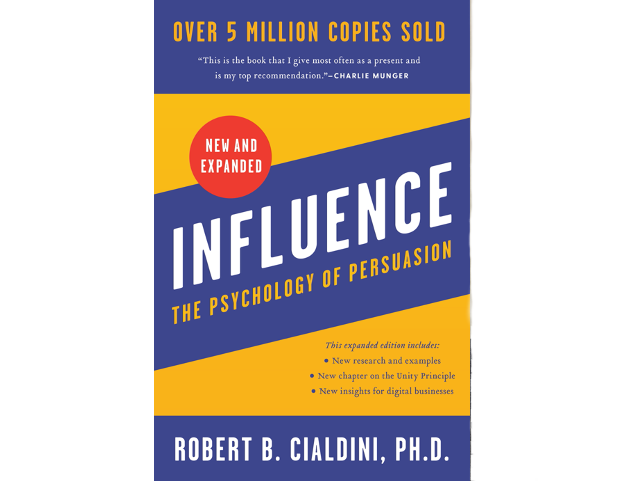Book Briefing: “Influence, New and Expanded: The Psychology of Persuasion,” By Robert Cialdini.

Share
It was the autumn of 2017, Zagreb. The trees were alight with color. The city was shimmering under the bright morning sun. I was proud of myself because I had completed a decade as a diplomat. I sauntered over to Ban Jelacic square, one of my favorite places in town. Today, work could wait while I enjoyed my moment. I sipped on my scalding hot, wonderfully bitter espresso as I watched people start their day. They had no idea, I thought to myself, how the world works. I, the proud diplomat of ten years, had so much more perspective. With a smirk on my face, I decided I would start this new book I had been recommended by a friend. Let’s see, I thought to myself, what this book about influencing others could tell me, the seasoned diplomat.
The Book
It didn’t take long before I was hunched over the book, coffee getting cold, and the realization dawning upon me that I did not, in fact, know anywhere near as much as I thought I did. It wasn't just that the book was expertly written, reducing complex concepts to easily digestible ideas, or that it neatly encapsulated dynamically evolving psychological concepts into actionable principles. It was also the realization that, had I read this book earlier, I could have saved myself years of figuring out how these concepts work in the field.
Years later, when the latest edition was published in 2021, I read it as if for the first time, and even though I have read it multiple times since, I can always extract new value from it. With new interactions, new places, new people, the book maintains it universal applicability; it provides a useful lens for added perspective.
This book is dynamic. The first edition was published in 1984, and has since witnessed multiple editions and offshoots, each of which introduces new concepts, updates older ideas, and elaborates on existing topics. It is a continuously evolving work that packages the accumulated insights of years of study and application into an engaging, easy to read text that grants you access to powerful principles of influence.
The book is divided into nine chapters, with a general outlook of the concepts in the beginning to introduce you to what is coming, and then seven chapters each covering one of Cialdini’s principles of Influence. The final chapter covers considerations applicable to the advent of digital technology.
Each of the principles - Reciprocation, Liking, Social Proof, Authority, Scarcity, Commitment and Consistency, and Unity- is illustrated with relatable examples or experiences that the author then uses to elaborate the concepts behind it and how it could play out in the real world. He introduces the concept gradually, guiding the reader to understanding how it works in different contexts, and provides readers the means to recognize when these principles are being used on them and how to counter their effects. He ends each chapter with a summary that captures the essence of the principle, and reinforces your understanding of the concept.
Core Themes: 1. Reciprocation

The chapter on reciprocation takes you on a brief exploratory journey on how reciprocation and reciprocity can be wielded to entice you to give more than you had intended to. It covers examples involving groups of people and individuals in situations that will sound all too familiar to anyone who walked away from a situation wondering why they ended up donating to a charity they’d never heard of or why they made that big purchase rather than taking the time to think about it. It discusses the universality and prevalence of this concept across history and geography and how it may have evolved as an adaptive feature of human societies. It also covers how the principle applies even if the initial offering is uninvited or unprompted, and focuses on how it can trigger unequal exchanges.
He discusses the power and longevity of the principle, and how it can instill an enduring obligation for the recipient and the collective pressures associated with fulfilling the obligations (returning the favor). He explains how reciprocation can be combined with other principles of influence and how understanding it can help neutralize its effects.
He connects the principle with the concept of repaying a debt to emphasize its impact, driving the point home by showing how the internal discomfort of being indebted and the external pressures to repay obligations together form a near insurmountable psychological hurdle.
Cialdini delves into the details and nuances of this principle through a series of examples, including collective, individual, historical and current. Then, right as you feel that it is an unescapable trap, he shows you how to defend against it by identifying and contextualizing the elements that trigger our reciprocation responses. He provides different tactics to neutralize the principle and recognize when it is being used maliciously, and how to turn the tables in your favor.
Think on how important reciprocation is within the world on international relations, to the point that it forms a cornerstone of engagement on both the macro and micro levels of engagement. Governments adhere to that principle when considering their treatment of diplomats, officials, and citizens, as well as in matters of taxes, tariffs and benefits. On the individual levels, initiating a cycle of reciprocity through a simple gesture or small gift of appreciation can strengthen connections and enhance communication.
Core Themes: 2. Liking

In the chapter on ‘Liking’, Cialdini tackles how liking someone can influence people and appeal to the emotional rather than logical parts of the brain when making decisions. He superbly illustrates how something that is difficult to quantify can impair your reasoning, and how it can replace logical arguments to win you over and direct you to a particular decision.
He uses examples of studies on the use of popular celebrities too endorse products, and others on the correlation between the popularity of doctors and the likelihood of malpractice lawsuits, and the commercialization of the principle by corporations and companies to drive sales. He elaborates on the differences between individual and collective situations where this principle is applied, and how they impact dynamics between individuals and groups.
He connects the principle to the others covered in the book, and highlights how it can be used to magnify their impact. He identifies the effects of this principle on interactions and the likelihood of swaying opinions in the face of facts, and without necessarily leveraging real knowledge or expertise to do so. He identifies the elements that make people more or less amenable to like someone, and how they factor into the equation of influencing others when making choices or decisions.
Cialdini, having explained the concept, then moves on to how it is wielded, and how ‘liking’ can be carefully crafted by operators in different fields to their advantage, and the methods through which liking can be manufactured. He points out that one of the reasons that this principle is so effective is because we often underestimate its impact on our reasoning. He further delves into how liking can be magnified over time and through various processes of connection and cooperation, and he further explores when it fails to yield results through either misunderstanding or misapplication.
In his section on how to defend against this principle he boils it down to a simple and effective formula based on self-awareness and pattern recognition. Because there are so many variables that affect liking, he instead redirects our attention toward identifying when we feel its effects, rather than try to counter its causes.
In that, we are able to recognize when we feel that we like someone more than the context of the interaction would dictate, and become more alert to the possibility that this principle is being wielded against us. Having recognized it, then advises on how to redirect our thinking toward the issue and not the person presenting it to neutralize its impact.
In diplomacy and broader engagement contexts in international relations, mutual appreciation results in smoother negotiations, more constructive conversations, more agreeability and an increased likeliness to exhibit flexibility. Liking also affects the tone with which an event or meeting is reported, and correlates with the tone of reporting.
Core Themes: 3. Social Proof

This principle is afforded considerable focus, both for its prevalence and the strength of its impact. He discusses the impact of this principle both in real world interactions as well as its online impact. He expertly illustrates the differences between the effects of this principle when the social proof is based on groups that we identify with compared to those we do not. He further highlights the difference between the effects of the principle when it is based on known versus anonymous sources (‘verified reviews’ versus ‘most people’ for example).
The author explains how we determine correct behavior by observing others. He elaborates on how the power of the phenomenon rests on the social evolution of humans, and why we tend to adopt socially acceptable norms when it comes to our decisions (socially acceptable behavior versus going against the group).
Cialdini elaborates on how the principle works in practice, explaining why we tend to adopt it as a mental shortcut for decisions to save ourselves the trouble of thinking too hard about every decision, and how this nigh automatic response is the lever that those who seek to exert influence use. He highlights how the principles of social proof can be wielded to counter other evidence that may sway decisions in another direction and therefore why it is so favored by marketers when seeking to make sales (the emphasis on positive reviews for example).
He includes several powerful examples in this chapter, two of which stand out considerably illustrating the impact of peer pressure. The first is the Chicago based cult led by Dorothy Martin, which predicted the end of the world, covered extensively in the book When Prophecy Fails. The second, more renowned, is that of the Jonestown mass suicide in Guyana led by the infamous Jim Jones.
Cialdini explains how the principle of social proof serves not only as an indicator of acceptable behavior, but also of what is possible. When we see others engaging in an activity, we feel reassured that it is feasible for us too, alleviating fears of failure and increasing the likelihood of engaging in the behavior.
After detailing the various elements of social proof, and how to recognize and use them, and how they can be used against you, he then devotes considerable time to explaining how to defend against its effects. Rather than fully disengage from social proof, which offers useful guidance, he emphasizes learning to filter reliable sources of information. He offers strategies for recognizing when social proof is being used against you and how to disconnect from it when necessary.
Social proof is an important element of international relations. It features prominently on both the macro levels, consider as an example a trend of increased applications by states to join economic blocs that arise when others obtain membership, or the likelihood of a head of government participating in an event when they are informed that a significant number of their counterparts will be attending.
Core Themes: 4. Authority

Under the heading of authority, Cialdini explores the levels of influence wielded by different types of authorities. He distinguishes between subject-matter experts and direct authority figures who leverage social or organizational hierarchies to exert control. Through a variety of examples and experiments, including the renowned Milgram experiment, Cialdini highlights the power of authority in influencing behavior.
The experiment demonstrates the extent to which people will obey authority even against their own best judgement. Here, Yale psychology professor Stanley Milgram tested obedience to authority by having an actor play the role of instructor who directed participants to deliver electric shocks of increasing intensity as punishment for wrong answers to what they thought was another participant in the experiment. The recipient of the shocks was another actor however and received no shocks, but the participants were not aware of that and delivered what they believed to be dangerously high levels of shocks on the instructions of the experimenter. Cialdini uses this example to drive home how authority can override personal ethics when people are placed in hierarchical settings.
Further elaborating, Cialdini explains how this principle is effective because of its evolutionary roots in human societies, where deference to authority helped societies function cohesively; without it, human groups may have devolved into anarchy.
After explaining the principle, he guides the reader through how it can be wielded to exert influence, given that deference to authority become reflexive if we are not vigilant and aware. He dissects how authority is used to steer decisions and identifies supplementary elements that either reinforce or weaken authority’s influence.
In the section on how to defend from the effects of this principle, Cialdini explains how to preempt its effects by assessing credibility and trustworthiness of authorities. He encourages readers to determine honesty and impartiality to evaluate whether an authority figure is truly credible or merely exploiting their position. He addresses how this principle is used in conjunction with others and how through understanding the concepts behind them we can buffer ourselves from their potential effects.
In international relations, authority, real or perceived, is phenomenally important. It influences both organizational and individual behavior. Most organizations that operate in the field are hierarchical, and therefore have authority embedded in them as a core aspect of engagement. Seniority and rank denote modes of engagement, as do positions of leadership within organizations, elevating the effects of the principle on the people staffing these organizations.
Core Themes: 5. Scarcity

In this principle, Cialdini underscores an important principle of human motivation: loss aversion is stronger than desire for gain. By creating scarcity and eliciting fear of losing out on an opportunity, people are able to influence our decisions. When faced with the prospect of loss, people are more likely to act than when presented with potential gains.
He explains how businesses and marketers exploit this principle by creating demand through deliberate undersupply. Cialdini then illustrates how scarcity, when combined with social proof, amplifies its effect -higher demand being the social proof, and low supply providing scarcity.
Referencing Daniel Kahneman’s prospect theory, which describes how people make decisions involving risk, Cialdini explains how loss aversion translates across individuals and the organizations they represent. He elaborates on the principle through how the fear of losing something (even something not yet gained) drives impulsive decisions. Using a variety of examples to showcase how this principle is wielded in practice, he addresses the internal drivers such as the fear of loss, and the external drivers such as competition from others for the (allegedly) limited opportunity.
Cialdini then outlines how scarcity increases the value of an offering by reducing choices, triggering resistance to loss of freedom of choice. This intensifies our desire for something previously available but now scarce. The principle is pervasive, applying to everything from material goods to information and opportunities. Driving the point home, he illustrates how it works in multiple contexts, from business to politics to art. He contextualizes the principle and how it may work better under certain conditions compared to others, and when we would be most vulnerable to its effects.
Having laid out the foundations of scarcity, Cialdini then provides the tools to understand and counter its effects when need be. He advises heightened self-awareness because scarcity hinders our mental processing. In raising our awareness of our susceptibility, he explains how we can then engage our logical processing to determine our actual need, instead of our reactiveness to scarcity.
Governments, in a reflection of individual reactions to scarcity, tend to react in similar patterns to real or perceived scarcity; when a government fears loss of access to a resource it will likely pursue more aggressive stances and engagement on ensuring continued access. Consider the stances of global powers faced with potential restrictions to access to resources or navigation corridors, and you will see how the risk of scarcity drives government and state behavior in a way that mimics individual behavior.
Core Themes: 6. Commitment and Consistency

Cialdini emphasizes our innate drive to honor commitments and maintain consistency. Once we make a public comment, we are more likely to follow through even if it was no longer in our best interests. In addition to honoring our commitments, we are also more likely to engage similar behavioral patterns in the future to avoid cognitive dissonance.
The author highlights how our urge to honor commitments can keep us in a disadvantageous position long after it would be logical to do so. When we commit to something, he explains, especially if we invest in it (time/money/effort/concessions), we are more likely to value it more as a result, and trigger the associated principle of scarcity because we fear losing it. Through a series of examples, he shows how small commitments early on can escalate to significantly bigger commitments as a result of this mental process.
Cialdini explains the reasons behind the power of commitment and consistency; to be seen as unreliable and inconsistent incurs negative social and professional repercussions. Furthermore, being consistent reduces the need to think actively about every decision, allowing you instead to measure how consistent it is with your previous ones.
Cialdini then explains how this principle is leveraged to influence our decisions. He ties the two elements together, with consistency being built on your prior commitments. Through a series of instances, historical and current, he explains how others can maneuver us to self-imprison in a cage of escalating commitments to a course of action that is detrimental to our self-interest.
Building on experiments conducted in the field to test the power of this principle, Cialdini explains how their findings help us understand the power of escalating commitments, beginning with trivial concessions and escalating to significant commitments of time and effort. In so doing he leads into how to defend against this principle.
The author emphasizes a very important point; not all consistency and commitment is bad. In fact, for the majority of the time it is beneficial, and therein lies the crux of defending against this lever of influence. Differentiating between necessary and beneficial commitments and consistency and rigid unthinking adherence is the key to defending against someone leveraging this principle against our interests.
In international law this principle manifests in multiple ways, including the declarations by states of their ratification of certain treaties and adoption of non-binding resolutions for instance. After publicizing support for a particular position or resolution, even if it is non-binding, a government is more likely than not to attempt to adhere to it.
Core Themes: 7. Unity

Cialdini superbly presents the case for how the principle of unity affects our decision making. He describes how human beings categorize others into “us” and “them,” with those in the “us” group more likely to receive our support and agreement. This principle draws on the tribal nature of human society, reinforcing the evolutionary drive to support one’s own group.
He explains how unity can be fostered and reinforced through sequential steps and collective efforts, and how this principle’s power harkens back to our tribal nature and the evolutionary drive to support our own. The author then illustrates how the different notions of ‘us’ develop in current times, and how these become identity affiliations that shape our opinions and behaviors.
Further reinforcing the power of the principle is that once we affiliate with a group, our identity becomes intertwined with it. Therefore, anything opposing the group's interests feels like a personal threat, and anything benefiting the group benefits us by association.
Having explained the tenets of the principle, Cialdini proficiently draws a map on how it can be used to influence decision making and how people take advantage of it for financial, political, and other purposes. He further elaborates on how this principle is widely used by groups to cover for their members’ misbehaviors and abuses, with loyalty taking precedence over ethical behavior and responsibility.
Cialdini shows how this principle is applied in various fields, from business to politics, and how it drives both loyalty and compliance. He highlights how unity can entangle with other principles, such as commitment, to further reinforce group influence.
In the defense section of this chapter, we learn that one of the more effective ways to combat the influence of this principle is to wield one of the other principles. Essentially, he explains that through the use of the commitment and consistency principle, you can ensure that ‘we’ or ‘us’ does not take precedence over ethical behavior. By committing to a certain code of ethics or set of behaviors, repeatedly and publicly, an individual or organization can ensure their precedence over the influence of unity.
Consider on the global arena the presence of regional blocs, economic alliances, defense alliances and other similar groupings, and how they affect state behavior. A state may engage in policies that align with that alliance and its connection to it that may not necessarily be in its direct interest for example.
The Value of the Book
This book is, without question, of immense value to practitioners in the field of international affairs. Not only for those aspiring to join the field, but also for seasoned veterans, it offers complex yet universally applicable principles relevant to diplomacy and international relations. I would go so far as to suggest that ministries of foreign affairs would be well advised to include this book as required reading for diplomats-in-training. I would have been very happy to have read this at the beginning of my career rather than a decade in.
The principles outlined in this book are ones that we encounter regularly, even daily, but having them presented together, and their mechanisms outlined and explained shifts our understanding from reflexive action to conscious and deliberate decisions. Over the course of a career in international relations and diplomacy, professionals will learn everything in this book, but it will take years of practice and engagement to do so, so why not save yourself the time and learn them in a few days?
The universality of Cialdini’s principles—rooted in human psychology rather than cultural specificity—adds to the book’s value. The information it contains is not only insightful and rooted in expertise, but also acts as a guidepost, directing readers who seek deeper knowledge to further reading through the book's extensive bibliography; the wealth of knowledge and expertise it draws upon and that it provides access to is incredible.
Readability
When I read academic papers and books on particular topics, I often found myself trudging through dense texts brimming with information but difficult to navigate. This book however feels like you are sitting by the campfire as Cialdini imparts his wisdom. It never feels dense, and at no moment did I find myself struggling to keep reading, quite the opposite I often had to force myself to put the book down telling myself I would just finish this page, maybe just this section, or just this chapter.
Cialdini's ability to distill complex, intertwined concepts into an easy-to-read format demonstrates his mastery. He doesn't complicate topics to showcase his expertise, instead presenting them with effortless clarity.
Highly Recommended
If it wasn't already clear, this book comes highly recommended for professionals in international relations and diplomacy. It is highly relevant to the field, whether you are involved in negotiations, in representing your organization or government, handling sensitive matters, leading multicultural teams, or engaged with the general public, the principles in this book will be of use to you.
Furthermore, it will sharpen your ability to recognize when others are trying to influence your decisions—whether from within your organization or externally. In a field where you are expected to make decisions behalf of your organization or government, and where almost everyone you engage with wants to sway your positions in their favor, knowing your susceptibilities to influence, and having the tools to counter them is a gamechanger.
In a context where influence is omnipresent, and decisions often have far-reaching consequences, understanding the principles of influence isn’t just advantageous—it’s essential. Cialdini’s insights are a powerful tool for professionals in international relations, providing concrete tools to navigate and neutralize the forces that shape our behaviors, both overt and subtle. This is more than a book—it’s a career companion.



